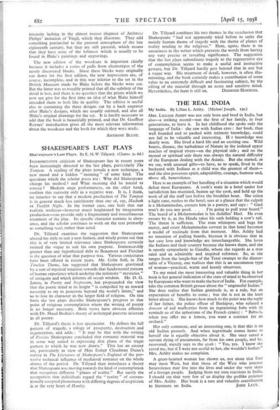SHAKESPEARE'S LAST PLAYS
Sha`cespeare's Last Plays. By E. M. W. Tillyard. (Chatto. 3s. 6d.)
INTERPRETATIVE criticism of Shakespeare has in recent years been increasingly directed to the last plays, particularly The Tempest. A reading of the plays reveals a new technique, a new mood and a hidden " meaning " of some kind. The questions which the scholar poses are : Why did Shakespeare change his method ? and What meaning did he intend to convey ? Modern stage performances, on the other hand, confirm this curiosity only in a negative way. It is, I think, no injustice to say that a modern production of The Tempest is in general much less satisfactory than one of, say, Macbeth or Twelfth Night. In the former case, one feels that our realistic tradition—however much heightened by imaginative production—can provide only a fragmentary and miscellaneous treatment of the play. Its specific character remains in abey- ance, and the scholar continues to work on the text primarily as something read, rather than acted.
Dr. Tillyard examines the suggestion that Shakespeare altered his style to suit a new fashion, and wisely points out that this is of very limited relevance since Shakespeare certainly twisted the vogue to suit his own purpose. Immeasurably greater than any hypothetical debt to Beaumont and Fletcher is the question of what that purpose was. Various conjectures have been offered in recent years. Mr. Colin Still, in The Timeless Theme, has suggested that Shakespeare gravitated by a sort of mystical intuition towards that fundamental pattern of human experience which underlay the initiatory " mysteries " of antiquity and which informs all occult wisdom. Mr. D. G. James, in Poetry and Scepticism, has propounded the view that the poetic mind at its height " is compelled by an inward necessity to try to penetrate beyond the world's limits," and so to lose its character in the larger field of religion. On this basis the last plays describe Shakespeare's progress to that point of religious contemplation where the writing of poetry is no longer necessary. Both views have obvious affinities with Dr. Maud Bodkin's theory of archetypal patterns inherent in all poetry.
Dr. Tillyard's thesis is less spectacular. He defines the full pattern of tragedy, a trilogy of prosperity, destruction and regeneration, and adds : " It may be that with the writing of Pericles Shakespeare concluded that romantic material was in some way suited to expressing that phase of the tragic pattern to which he was now drawn." This has an uneasy air, particularly in view of Miss Esther Cloudman Dunn's survey in The Literature of Shakespeare's England of the per- vasive technical influence of mediaeval romance on the whole drama of the period. Dr. Tillyard then introduces • a theory that Shakespeare was moving towards the kind of contemplation that recognises different " planes of reality." But surely the recognition that individuals regard the " reality " of conven- tionally accepted phenomena with differing degrees of scepticism is at the very heart of Hamlet.
Dr. Tillyard combines his two themes in the conclusion that Shakespeare " had not apparently tried before to unite the mainly human theme of tragedy with the theme of planes of reality tending to the religious." Here, again, there is an uneasiness in the writer which prevents the words from having any very precise or revealing significance. The suggestion that the last plays subordinate tragedy to the regenerative eye of contemplation seems to make a useful and instructive gesture, but Dr. Tillyard hardly gets beyond that in any but a vague way. His treatment of detail, however, is often illu- minating, and the book certainly makes a contribution of some value to an extremely difficult and fascinating subject, by the sifting of the material through an acute and sensitive mind.
Nevertheless, the hunt is still on. DESMOND HAWKINS.






































 Previous page
Previous page